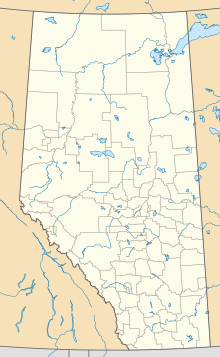Armena is a hamlet in Alberta, Canada within Camrose County.[2] It is located approximately 21 kilometres (13 mi) northwest of Camrose along Highway 21 and has an elevation of 745 metres (2,444 ft).
Armena | |
|---|---|
Location of Armena in Alberta | |
| Coordinates: 53°07′21″N 112°56′56″W / 53.1225°N 112.9489°W | |
| Country | Canada |
| Province | Alberta |
| Census division | No. 10 |
| Municipal district | Camrose County |
| Government | |
| • Type | Unincorporated |
| • Governing body | Camrose County Council |
| Area (2021)[1] | |
| • Land | 0.7 km2 (0.3 sq mi) |
| Elevation | 745 m (2,444 ft) |
| Population (2021)[1] | |
• Total | 37 |
| • Density | 53.2/km2 (138/sq mi) |
| Time zone | UTC−7 (MST) |
| • Summer (DST) | UTC−6 (MDT) |
| Website | Hamlet of Armena |
The hamlet is located in Census Division No. 10 and in the federal riding of Crowfoot.
Demographics
editIn the 2021 Census of Population conducted by Statistics Canada, Armena had a population of 37 living in 17 of its 18 total private dwellings, a change of -11.9% from its 2016 population of 42. With a land area of 0.7 km2 (0.27 sq mi), it had a population density of 52.9/km2 (136.9/sq mi) in 2021.[1]
As a designated place in the 2016 Census of Population conducted by Statistics Canada, Armena had a population of 42 living in 16 of its 16 total private dwellings, a change of -10.6% from its 2011 population of 47. With a land area of 0.7 km2 (0.27 sq mi), it had a population density of 60.0/km2 (155.4/sq mi) in 2016.[13]
See also
editReferences
edit- ^ a b c d "Population and dwelling counts: Canada and designated places". Statistics Canada. February 9, 2022. Retrieved February 10, 2022.
- ^ "Specialized and Rural Municipalities and Their Communities" (PDF). Alberta Municipal Affairs. June 3, 2024. Retrieved June 14, 2024.
- ^ Census of Canada 1966: Population (PDF). Special Bulletin: Unincorporated Places. Vol. Bulletin S–3. Ottawa: Dominion Bureau of Statistics. 1968. Retrieved September 25, 2024.
- ^ 1971 Census of Canada: Population (PDF). Special Bulletin: Unincorporated Settlements. Vol. Bulletin SP—1. Ottawa: Statistics Canada. 1973. Retrieved September 25, 2024.
- ^ "Geographical Identification and Population for Unincorporated Places of 25 persons and over, 1971 and 1976". 1976 Census of Canada (PDF). Supplementary Bulletins: Geographic and Demographic (Population of Unincorporated Places—Canada). Vol. Bulletin 8SG.1. Ottawa: Statistics Canada. 1978. Retrieved September 26, 2024.
- ^ 1981 Census of Canada (PDF). Place name reference list. Vol. Western provinces and the Territories. Ottawa: Statistics Canada. 1983. Retrieved September 26, 2024.
- ^ 1986 Census of Canada (PDF). Population. Vol. Unincorporated Places. Ottawa: Statistics Canada. 1988. Retrieved September 26, 2024.
- ^ 91 Census (PDF). Population and Dwelling Counts. Vol. Unincorporated Places. Ottawa: Statistics Canada. 1993. Retrieved September 26, 2024.
- ^ 96 Census (PDF). A National Overivew: Population and Dwelling Counts. Ottawa: Statistics Canada. 1997. Retrieved September 26, 2024.
- ^ "Population and Dwelling Counts, for Canada, Provinces and Territories, and Census Divisions, 2001 and 1996 Censuses - 100% Data (Alberta)". Statistics Canada. August 15, 2012. Retrieved September 19, 2024.
- ^ "Population and dwelling counts, for Canada, provinces and territories, and designated places, 2006 and 2001 censuses - 100% data (Alberta)". Statistics Canada. July 20, 2021. Retrieved September 19, 2024.
- ^ "Population and dwelling counts, for Canada, provinces and territories, and designated places, 2011 and 2006 censuses (Alberta)". Statistics Canada. February 8, 2012. Retrieved September 19, 2024.
- ^ a b "Population and dwelling counts, for Canada, provinces and territories, and designated places, 2016 and 2011 censuses – 100% data (Alberta)". Statistics Canada. February 8, 2017. Retrieved February 13, 2017.
53°07′21″N 112°56′56″W / 53.12250°N 112.94889°W
